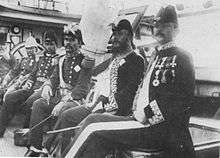Samoan Civil War
The First Samoan Civil War refers to the conflict between rival Samoan factions in the Samoan Islands of the South Pacific. The war was fought roughly between 1886 and 1894, primarily between Samoans fighting over whether Malietoa Laupepa or Mata'afa Iosefo would be King of Samoa. However, the German military intervened on several occasions. There was also a naval standoff between the United States, Germany, and the United Kingdom. After the 1889 Apia cyclone destroyed six of the German and American ships stationed at Samoa, the three countries decided that Laupepa would be the King.[2]
| First Samoan Civil War | |||||||
|---|---|---|---|---|---|---|---|
| |||||||
| Belligerents | |||||||
|
Supporters of Mata'afa Supported by: |
Supporters of Laupepa | ||||||
| Commanders and leaders | |||||||
|
|
| ||||||
Background
Germany fought in Samoa in defense of Tamasese, their choice for Tafa'ifa, the King of Samoa, after the reigning king Malietoa Laupepa was usurped and exiled. Tamasese and his German allies faced a rival faction, headed by popular Samoan chief Mata'afa Iosefo. Germany was looking to expand its new empire and its commercial interests. America, also looking to protect its commercial interests in Samoa, sent three warships—USS Vandalia, Trenton, and Nipsic—to monitor the island. Britain also sent a ship to protect its interests, HMS Calliope.

The prime minister of the kingdom of Hawaii Walter M. Gibson had long aimed to establishing an empire in the Pacific. In 1887 his government sent the "homemade battleship" Kaimiloa to Samoa looking for an alliance against colonial powers. It ended in suspicions from the German Navy and embarrassment for the conduct of the crew.[3]
War
Tensions heightened with the United States after a German shelling of Mata'afa's rebel villages also resulted in destruction of American owned property in 1887. One battle at Vailele in September 1888, following German bombardment of his rebel villages, resulted in Mata'afa's warriors destroying an invading German contingent and plundering their plantations.[4] Throughout the war, the German, American, and British ships were in a naval standoff known as the Samoan crisis. The three western powers finally agreed that Malietoa Laupepa would be restored as King of Samoa in 1889 after a cyclone destroyed both American and German warships at Apia harbour, halting hostilities between the powers.[5] However, the conflict on Samoa went on until 1894, when Laupepa became king again.
Second Samoan Civil War
Nine years later, with the death of Malietoa Laupepa, hostilities broke out again in 1898 in the Second Samoan Civil War. However, this conflict was quickly ended by the partitioning of the island chain at the Tripartite Convention of 1899.
See also
References
- Morlang (2008), p. 128.
- Editor. "Samoan Showdown – Germany Risks War With America In The 1880s | Militaryhistorynow.com". Archived from the original on 2014-10-18. Retrieved 2016-03-29.CS1 maint: extra text: authors list (link)
- McBride, Spencer. "Mormon Beginnings in Samoa: Kimo Belio, Samuela Manoa and Walter Murray Gibson". Brigham Young University. Retrieved 24 May 2020.
- Kohn, George C (1986). Dictionary of wars, Third Edition. Facts on File Inc, factsonfile.com. pp. 479–480. ISBN 0-8160-6577-2.
- Stevenson, Robert Louis (1892). A Footnote to History: Eight Years of Trouble in Samoa. BiblioBazaar. ISBN 1-4264-0754-8.
Bibliography
- Stevenson, Robert Louis. "VII_The Samoan Camps". A Footnote to History: Eight Years of Trouble in Samoa. eBooks@Adelaide, The University of Adelaide Library. p. 49. ISBN 978-0-8248-1857-9. OCLC 227258432.
- Morlang, Thomas (2008). Askari und Fitafita. "Farbige" Söldner in den deutschen Kolonien (in German). Berlin: Ch. Links Verlag.CS1 maint: ref=harv (link)

